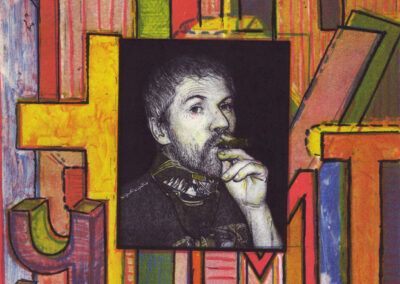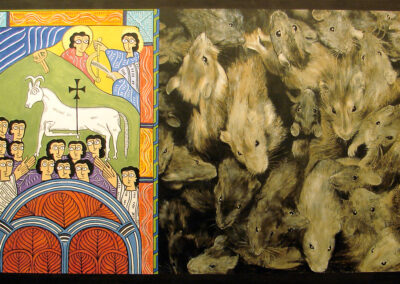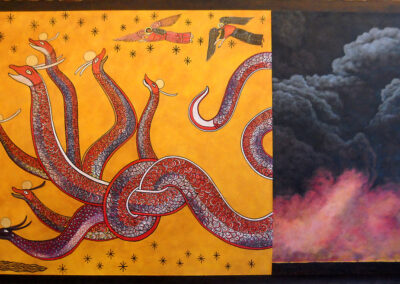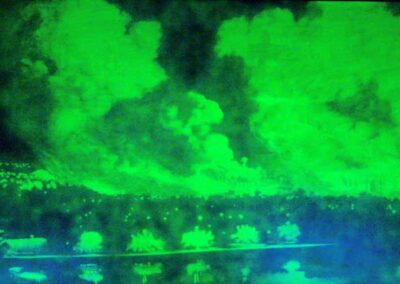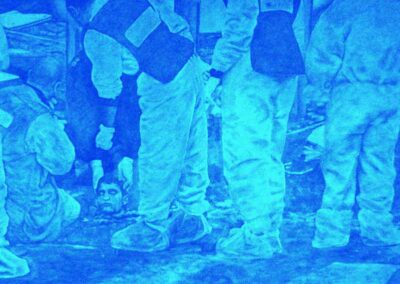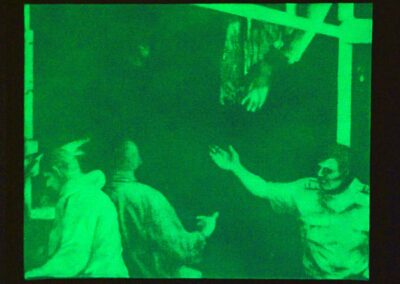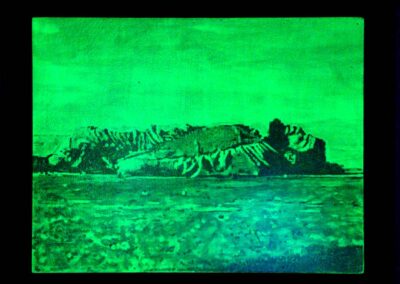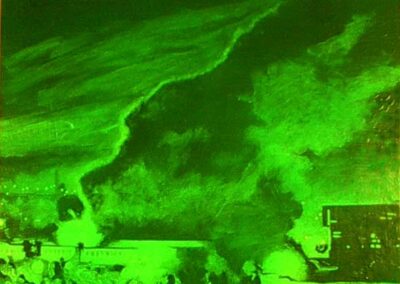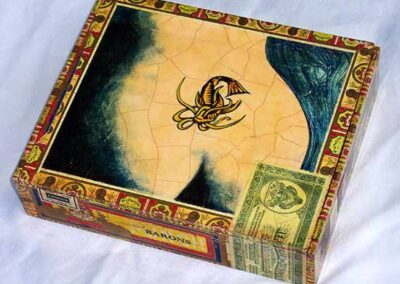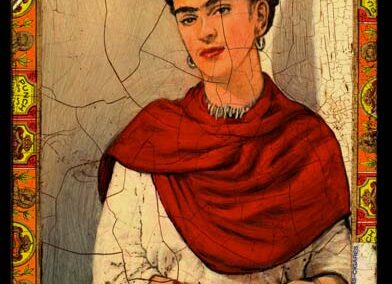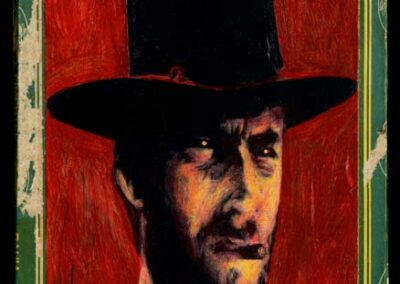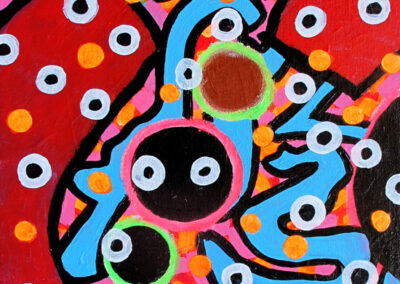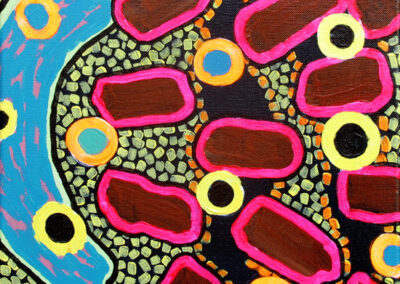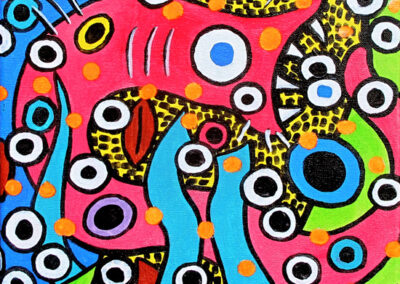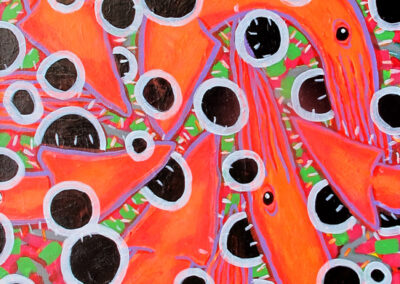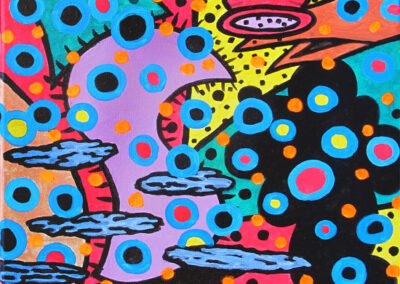Our next Artist You Need To Know was a significant artist and community activist in Niagara. Tobey Anderson‘s (1946 – 2014) legacy as an artist, educator and cultural worker is still very prevalent, after his passing.
From a lovely tribute written by NAC Director Steve Remus: He was adamant about the distinction between Sunday painters and the artists who were devoting their life to making concept-based art work. He was also adamant about the place of the artist in society, how valuable it is. For Tobe, the artist had a role in bringing attention to what the rest of us were ignoring. This is evident in his work and through his life–political fights for justice, hard questions about the forces of good and evil, and fearless reminders about our mortality. He earned a tremendous amount of respect for the art work he made, it challenged his audiences and it also challenged other artists. His absence leaves an unfillable space in the St. Catharines arts community.
-
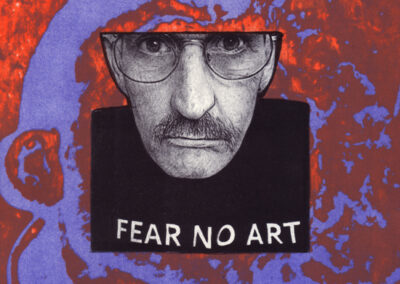
Fear No Art, 2010
-

Carolyn #1, 2010
-

Master Plus, 2010
-

Lamb of God / Pestilence, 2011
-

7 Headed Serpent / Gulf Fires, 2011
-

Into The Hell Hole / Haiti, 2011
Anderson grew up in Iowa, but was born in Washington, D.C; after emigrating to Ontario in 1969, he spent a decade in Kingston, producing artworks as well as teaching in the Visual Arts Department at St. Lawrence College. In 1975, he became a Canadian citizen.
Tobey C. Anderson began exhibiting widely in 1969 and was awarded several grants from the Ontario Arts Council. Many private and public collections in Canada, U.S.A., and Cuba have Anderson’s artwork.
However, Anderson is perhaps best remembered for his commitment to community. He was the Founding President of Kingston Artists’ Association Inc./ Modern Fuel Artist-run Centre (Kingston, ON) and was President of Artspace in Peterborough (at Artspace he worked alongside many other important artists and activists in the provincial and national artist-run network across Canada, including Dennis Tourbin). For the span of 1990 to 1998, he was Director of Niagara Artists’ Centre in St. Catharines.
In 2003 Anderson was commissioned to produce a large painting installation for the Kirkwood Community College Foundation in Cedar Rapids, Iowa, U.S.A.; and one of his major bodies of work, that toured to many venues, was The New American Century Project, (which he produced from 2004-2012). We’ve shared several images from that series below.
-

New York, from the Shock & Awe Trilogy
-

Baghdad, from the Shock & Awe Trilogy
-

Jerusalem, from the Shock & Awe Trilogy
-

Jerusalem Bombing, Night Vision series, 2004
-

Dead Iraqi, Night Visions series, 2004
-

Baghdad #2, Night Vision series, 2004
In Niagara, Tobey Anderson was the Inaugural Chair of the Culture Committee (for the City of St. Catharines) following his participation in the development, adoption, and implementation of a new Cultural Policy for the city. He was honoured with the Mayor’s Trillium Award for Artistic Excellence, from the same municipality, in 2005. A year later, he founded the ‘CRAM Collective and CRAM International and Canada’s smallest art gallery featuring exhibitions of contemporary artists with strong ties to Niagara. In 2009 he initiated CRAM Press, Niagara’s premier print workshop. CRAM International [was] managed on a benevolent dictatorial management model and [beginning in] 2008 had an on-going relationship of cultural exchange with Taller Cultural “Luis Diaz Oduardo” in Santiago de Cuba. [In tandem with this] Anderson was the recipient of an Ontario Arts Council International Artist Residency Grant and spent six weeks in Santiago de Cuba in Dec 2011 – Jan 2012.’ (from his site)
-

From the Cigar Box series, 2005 - 2006
-

From the Cigar Box series, 2005 - 2006
-

From the Cigar Box series, 2005 - 2006
-

From the Cigar Box series, 2005 - 2006
-

From the Cigar Box series, 2005 - 2006
-

From the Cigar Box series, 2005 - 2006
Significant exhibitions of his work include the Agnes Etherington Art Centre (Kingston, ON); Grimsby Public Art Gallery (Grimsby, ON); Spectrum Gallery (San Diego, CA); Niagara Artists Center (St. Catharines, ON); Modern Fuel Artist-run Centre (Kingston, ON); Rodman Hall Art Centre (St. Catharines, ON); Galerie d’Art du Centre culturel, de l’Université de Sherbrooke, (Sherbrooke, QC); and Galeria Universal, Santiago de Cuba (Havana, Cuba). A more extensive accounting can be found here.
-

Silken Twine Series, 20132013
-

Silken Twine Series, 2013
-

Silken Twine Series, 2013
-

Silken Twine Series, 2013
-

Silken Twine Series, 2013
-

Silken Twine Series, 2013
His Silken Twine series was recently featured in the exhibition A Place To Stand: The Legacy of Rodman Hall Art Collection (2021 – 2022). The curator offered the following about this final body of work from Anderson: These pieces take their name from a poem by William Blake; specifically “It is right it should be so: Man was made for joy and woe; And when this we rightly know Through the world we safely go. Joy and woe are woven fine, A cloth for the soul divine. Under every grief and pine Runs a joy with silken twine..” The Silken Twine works are an artistic response by Anderson to how he “endured serious medical issues that would lay most people low, but he powered through with a strength and uncomplaining perseverance that was a testament to his character.” ( the latter part of that quote is from Peter Wing, from Lives Lived: Tobey C. Anderson, The Globe and Mail, May 2014)
More of Tobey C. Anderson’s artwork, and much more about his contributions to art and culture in Canada and beyond, can be seen here, at his site.


